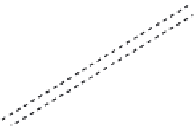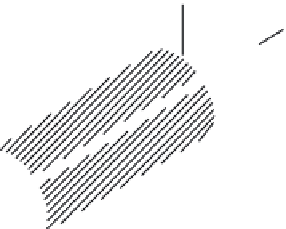Biomedical Engineering Reference
In-Depth Information
I
Jacket
material
FIGURE 4.9
Acoustic pressure transduction mecha-
nism. Increase in ambient pressure
causes jacket to elongate in the
I
direc-
tion. This strain is transferred to the fiber
increasing its optical phase length.
a
4.6 OpticalFiberCharacteristics
Single-mode fibers used in fiber sensors place stringent connectivity toler-
ances on the system relative to those in the multimode fiber system. Rayleigh
scattering caused by the glass imperfections is the intrinsic optical loss mech-
anisms in the fiber. This loss generally decreases with increasing wavelength
from the visible to the infrared. Because of this and other attenuation factors,
the best region for transmitting signals through optical fibers is between
1100 and 1600 nm. The region from 800 to 900 nm is also relatively favorable
for transmission; since sources and detectors for this wavelength range are
better developed, it is often the operating region for fiber sensors.
The analysis of single-mode fibers is fairly straightforward, since wave-
guide theory produces approximations to the mathematical description of
waveguide parameters. Coupled with knowledge of the core cladding disper-
sion characteristics, this permits the determination of the range-bandwidth
product. With single-mode fiber transmission, an operating wavelength can
be determined where both attenuation and dispersion factors are at optimal
values for the selected fiber. Of more direct importance to the fiber system is
a consideration of the various sources of induced phase modulation and the
fiber system response to these perturbations. Variations of the normalized
propagation constant due to variations of core diameter and refractive index
have been shown to be negligible [7]. This leaves the consideration of various
environmental effects such as temperature and pressure (or acoustic) sensi-
tivity of the fiber length. If the optical path lengths of the two sensor arms
are equal to within the coherence length of the laser, the desired interfer-
ence effect occurs. A change in the relative phase of the light between fibers
appears as a change in fringe position or light intensity at the detector.
A detailed analysis of the effects of strain induced by the difference in
the thermal expansion coefficients between the various regions of the sen-
sor is necessary for the prediction of thermal sensitivity. Temperature effects


























































































































































































Search WWH ::

Custom Search